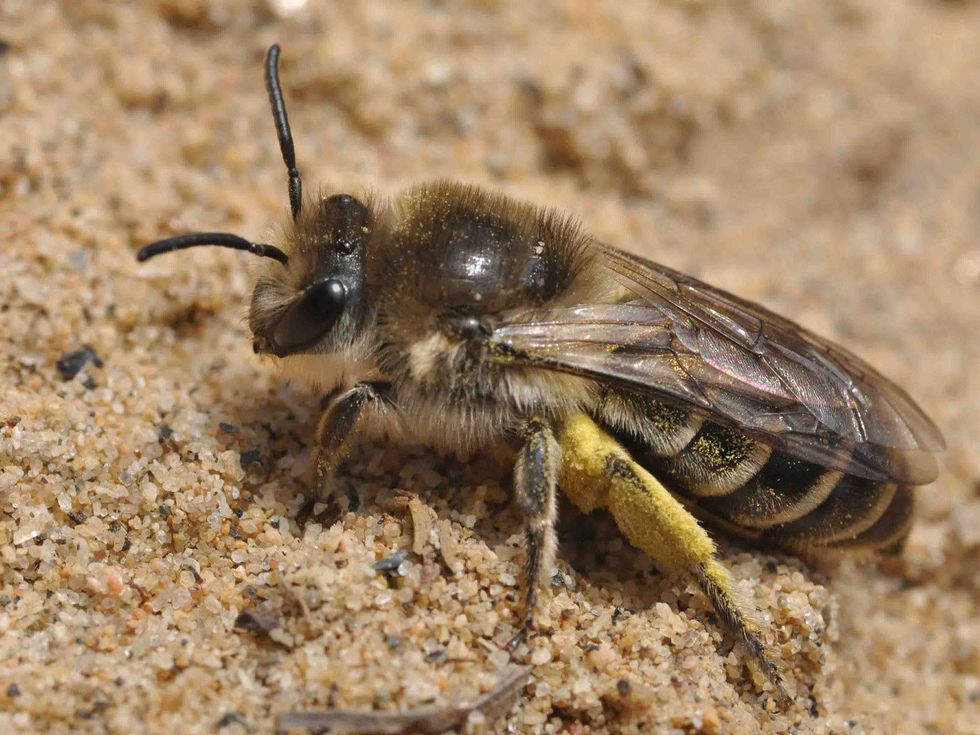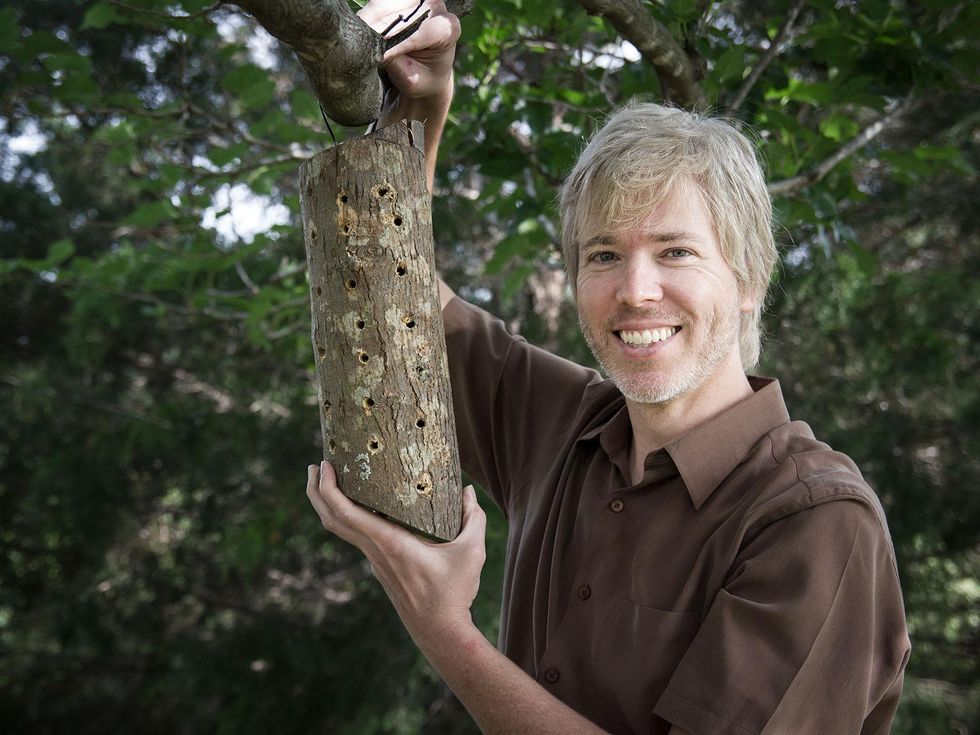The Farmer Diaries
North Texas farmer pleads the case for native bees
Honestly, I grow slightly perturbed whenever anyone goes on and on about honeybees. They have been in the news a lot lately. Maybe you've seen the alarmed reports about the honeybee's declining population, colony collapse disorder and the mysteries surrounding their demise.
But, for me, the honeybee is just part of the story, a mere scratching of the surface of the world of pollinators.
My experience with honeybees goes back to when I started a hive at age 13. I learned everything I needed to get started from the book, First Lessons in Beekeeping, copyright 1917 by C.P. Dadant, checked out from Sims Library in Waxahachie.
As a farmer, I consider how I can make sure our native bees stick around and pollinate our crops, especially if our imported honeybees do eventually die out.
My aunt Doris Jean was with my mother and me when we returned the book on its due date. She was so impressed with my enthusiasm about bees, she gave me $50 toward whatever I needed to become a beekeeper.
So I bought a hive, and the bees thrived. But after the first year, I could not bring myself to take the honey my bees had worked so hard to store. Drunk with honey, they flourished so much that, before I could divide the expanding hive into smaller hives, they split for better digs elsewhere. I ultimately failed because they had so thoroughly succeeded. By that time, almost two years had passed; two years of work had flown away.
But the experience was not a total loss. I learned a lot. Most important among my lessons was that honeybees, despite all the feelings we have for them being "natural," are not natural to North America. They are imports from Europe, brought by the early colonists. To continue to make it in this new land, honeybees need occasional help in the form of antibiotics. To me, this was not a sustainable practice.
Solitary bees
Years later, I became acquainted with North America's humble native bees. Known as solitary bees because they don't form hives, our native bees are far more abundant pollinators than the imported European honeybee, and they do just fine without our pharmaceuticals.
As a purist, I've become intrigued by solitary bees. And as a farmer, I consider how I can make sure our native bees stick around and pollinate our crops, especially if our imported bees do eventually die out.
Étienne Normandin, an entomologist whose blog is devoted to all things insect, has spent a great portion of his career researching native bees.
"People know about the honeybee, they know about the bumblebee, and that's pretty much it," Normandin says. "But hundreds of types of native bees are pollinating the majority of the plants in nature."
Entomologist Étienne Normandin says not all flowers and crops do well by the honeybee. "Hundreds of types of native bees are pollinating the majority of the plants in nature," he says.
Normandin says that, if the imported honeybee should disappear, we could still rely on our native bees for pollination. However, he warns that, "If the native bees should disappear, the whole ecosystem would collapse."
Furthermore, not all flowers and crops do well by the honeybee. "For example, with the apple tree, the best pollination occurs with a combination of honeybees and native bees," he says. "But some are specifically suited for native bees, such as cranberries, blueberries and strawberries."
Some crops even have specialized bees. "You have very specialized bees such as the squash bee, and they're very good at what they do: They pollinate squash," Normandin says.
"Honeybees are not good pollinators of squash or pumpkin flowers. Honeybees are attracted to the color and can visit the flower. But the squash bees are the best pollinators for these crops."
According to Normandin, many farmers and gardeners wrongly believe that honeybees are the ultimate aid in crop pollination, with little consideration for our native bees. That includes mowing or tilling the grassland around orchards and fields, which eradicates their habitat.
"Seventy percent of native bee species are ground-nesting bees," he says. "When we turn the soil around, we destroy their nests. Native bees are vulnerable to fragmentation of their habitat from mowing, construction or any activity that disturbs the soil and reduces the resources available to them."
One of the main threats to native bees is the new class of insecticides known as neonicotinoids, neonics for short, which infuse every cell of the plants to which they're applied and can compromise the bee's immune system. Native bees have evolved over millions of years to deal with the parasites and viruses that can infect them. When these insecticides contaminate the bees, though, they die from otherwise mild illnesses.
One other notable difference with native bees: They're less aggressive and therefore less likely to sting.
A native bee how-to
Normandin offers tips on how to increase native bees around the farm or garden and ensure that our crops have adequate pollination:
- Don’t use insecticides — ever! We can't expect to spray insecticides and kill only the bad bugs. All are affected one way or another.
- Let some land go wild. Mowing disturbs native bee habitat and reduces their nectar source.
- Don't till the soil beyond what's needed for crop plants.
- Plant a large diversity of flowering, native plants and make sure something is in bloom at all times. The smaller the flower, the better, because many native bees are small and need tiny flowers.
Following his recommendation, I made a home for cavity-nesting native bees that usually lay their eggs in holes left by wood-boring insects in dead trees. I drilled 5/16-inch holes in a log, as deep as the drill bit but not deep enough to go through to the other side of the log.
I spaced the holes at least an inch apart and filled up the log with as many holes as I could fit. My intent was to re-create a sort of dead tree limb full of bore holes. I attached it to a tree limb about six feet up from the ground.
Normandin assured me that native bees will eventually fill the holes with chambers of offspring and plug the holes with a cap by fall. A new generation of bees will emerge the following spring, and they'll fill even more holes. During the time they fill the holes with bee brood, native bees visit flower after flower to gather nectar, thereby pollinating flowers far and wide.
I felt like Normandin understood my misgivings about how much attention the honeybees get — hailed as the end-all, be-all of pollinators. Because their hives are mobile, honeybees can be trucked into orchards and farms when crops need pollination, then trucked out after they've done their job. Farmers pause their insecticidal practices just long enough to let the honeybees in and out. Native bees in the area don't stand a chance.
I see our use of honeybees as a cog in the wheel of industrialized agriculture; its demise is a symptom of our food system's unsustainability. That's the real story about colony collapse disorder. It's not just the honeybee that deserves our attention. It's the whole ecosystem.




